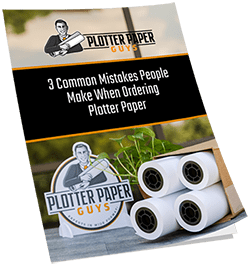Plotter paper rolls come in an array of sizes, and there are many different uses for them.
You can use inkjet plotter paper rolls to create architectural drawings, business presentations or posters. In fact, you can use them to create just about any other wide format project that you can imagine. However, there’s such a wide selection that it may seem difficult to choose the right size.
Plotters are great for projects where you need to print out large amounts of detailed work. Architectural drawings are a good example. Otherwise, you may want to use different-sized rolls depending on what your plotter can handle.
Here, we’ll cover these points and more. To learn more about the most common sheet sizes and uses of plotter paper rolls, keep reading.
Is a Plotter a Printer?
First, it may help to understand the difference between a plotter and a printer.
A plotter paper roll is a special kind of media for use with a plotter machine. Plotter machines are printing devices used along with computer programs, such as CAD. A user may also use other technologies and drawing software.
These kinds of devices print vector-type graphics. It renders the graphics using a ink system that moves across the plotter paper. Often, professionals such as architects and designers use plotters to create blueprints.
The plotter captures the graphics created by the architect or designer’s computer program. There’s a wide selection of paper available for printing vector graphics.
There are many plotter paper roll sizes and textures of plotter paper available. Typically, you’d buy plotter paper by the roll.
The roll wraps around the drum plotter. Meanwhile, the plotter draws the vector image on the drum plotter.
In this way, designers can create intricate diagrams and layouts. However, plotters aren’t limited solely to creating blueprints.
For instance, a user might use a plotter to create a large-format banner or sign. In that case, they’d typically make use of wide format inkjet printers.
Precision Printing With the Right Plotter Paper Roll
A wide format printer is highly specialized. If you’ve never seen one, it doesn’t quite look like a printer.
In addition, it doesn’t inject droplets on a page, like modern inkjet printer. Nor does it use a drum and toner like a copier.
Instead, pen plotters uses a pen attached to a metal arm. The arm moves horizontally across the page.
A CAD program controls all the movement of the arm. It performs this task by feeding coordinates to the plotter. The result is a highly accurate, sophisticated and crystal-clear drawing.
With a plotter printer, you’ll enjoy precise, high-quality printing. All your project details will render as desired. Furthermore, you’ll see that a plotter is an excellent choice for printing quick, inexpensive check plots.
The quality of the final draft depends on a number of factors. One such factor is the type and grade of paper used for printing.
The paper you choose is just as important as choosing the right plotting equipment. Accordingly, you’ll want to make sure to do your research before buying plotter paper.
Plotters in Action
Plotter printers are highly efficient. Paired with engineering bond paper, they produce amazing accuracy and clarity.
Industries that design and construct things have embraced this technology for this reason. These industries include:
• Architecture
• Construction
• Custom signage
• Electronics
• Engineering
• Interior design
• Product design
Even professional mapmakers have made plotters a normal part of their workflow due to the incredible accuracy of the equipment. What’s more, they also make use of mylar film to create highly detailed and accurate map overlays.
Plotters enable designers to create perfect copies of all kinds of documents. Over the years, there have been many innovations in the scope of materials and inks.
There have even been improvements in the kinds of projects that plotters can manage. Also, plotters have evolved to meet the exacting needs of highly technical industries.
Furthermore, it helps to understand that plotters serve the needs of professionals who need wide format printing. Wide format printing is any project that requires paper that’s larger than 8.5 x 11”.
It enables the creation of many things. These items include:
• Blueprints
• Charts
• Maps
• Posters
In fact, you can use a plotter to create anything in a larger size so that it’s easier to view intricate details. If it’s intricate details you want, you may find bright white plotter paper helpful.
What Is Plotter Paper Used for?
Plotter paper is a special paper for plotter printers. For example, you might operate a screenprinting business. Alternatively, you may run a sign-making business.
Again, architects frequently use plotters for printing. In any of these scenarios, you’ll want to know more about the right plotter paper roll size. With so many choices, it can sometimes prove confusing to understand how plotter paper sizes work.
Hopefully, you’ll find the following information helpful.
Again, a plotter is typically guided by a computer aided design program. The software outputs large vector designs, like those used for architectural blueprints. It’s especially useful for printing vector-type graphics.
Plotter paper is a kind of specialty paper for plotters. Plotters can print on a range of mediums, such as cardboard, shower curtains, vinyl—and, of course, plotter paper.
Just like with any printer, there are different types of plotter paper rolls available for your project. You’ll have quite a few choices to make if you want to make the right selection.
There are a few characteristics of plotter paper that are important to understand when choosing a plotter paper size. As such, let’s break down the most common characteristics of paper used for a plotter printer.
What Is the Paper Size for a Plotter?
In most cases, the size of your plotter will determine the right sized paper for your needs. Still, it’s important to understand various plotter paper sizes.
By understanding paper plotter sizes, you can make an informed decision. What’s more, you can save time and money by choosing the right paper for your project.
Here, you’ll need to think about the needs of your project as well as your plotting equipment. With this information, you can buy your next plotter paper roll with confidence.
The following are a few characteristics for you to consider.
Paper Roll Length
Manufacturers measure plotter paper in feet. A thicker roll of plotter paper may measure around 150 feet long—more on thickness in a moment.
These rolls are much shorter than the average plotter paper roll. Other rolls might measure as long as 300 feet long. You can even purchase a 500-foot long roll of plotter paper.
Paper Roll Width
Width is another important feature of plotter paper. Manufacturers measure plotter paper roll width in inches.
Here, it’s important to choose the right width for your plotter. Common plotter role sizes are 22, 24, 30, 34 and 36 inches.
You can tell the width of a plotter role by looking at the item number. The first two numbers are usually the wideness of the roll.
What Paper Size Is a 36 Roll?
When choosing the width of plotter paper, you also want to consider the orientation of your final project. For instance, you’ll most likely want a 24” x 36” final product if you need to render an architectural drawing.
In this case, it’s easy to assume that a 24 inch plotter paper roll will do the trick. Of course, a 24” plotter paper will get the job done. However, it might not serve as the most efficient size for your needs.
For example, you may need to render a project in landscape orientation. In that case, a 36” plotter paper roll is a better option, assuming that your plotter can accommodate it.
Alternatively, you may need a specialized width such as an A0 plotter paper roll size. You may also need special bond paper rolls for seismic-well log printing. You may even need water-resistant inkjet paper.
A good supplier can help you to source CAD inkjet bond and other kinds of specialty paper. With this in mind, you might wonder, “How do I find the perfect plotter paper roll near me?”
Luckily, you’re in the right place for the answer, but first, let’s review a few more different characteristics of plotter paper sheets.
Paper Roll Weight
You’ll also want to think about the weight of a plotter paper roll. Many plotters use 20 lb plotter paper.
36 lb and 24 lb rolls are also common plotter paper weights. Here, it’s important to choose the right weight paper for your plotting device.
Paper Roll Core Diameter
Finally, the core diameter is the measurement of the cardboard tube inside of the plotter paper roll. Most inkjet plotter printers use 2 inch core rolls.
Xerographic machines typically use a 3 inch core. However, this isn’t always the case. Accordingly, it’s important to make sure that your paper plotter roll has the right size core to fit your plotter.
Create Phenomenal Deliverables With the Right Paper
Plotters are different in that they use wide format paper. Nevertheless, they maintain remarkably high quality resolution. The more that you learn about plotter paper, the more you realize you have a wide range of options.
You can even purchase plotter paper for first drafts. This kind of paper is an inexpensive option that you can use with black ink only.
You can also purchase plotter paper especially for client presentations. For instance, you might choose special photo paper to produce high-quality images.
Likewise, you can purchase plotter paper designed especially to provide vivid color renderings. Alternatively, you can purchase a durable plotter paper designed for long-term storage.
No matter what plotter paper you choose, you’ll enjoy the benefits of accuracy, speed and uniformity. What’s more, these devices are amazingly efficient. However, these are only a few of the benefits of plotters.
With a plotter, you can complete the same project indefinitely without degradation or loss of quality. However, you need high-quality paper to accomplish this task. Accordingly, you’ll want to choose your paper supplier wisely.
Source Your Plotter Paper Domestically
You may have heard about the plotter paper roll price in Pakistan. At first glance, it may seem like a great bargain.
However, there are plenty of reasons why you should source your plotter paper from the US. For instance, US manufacturers are held to high standards of quality. They also use higher-quality materials that can minimize paper jams and other malfunctions.
High-quality plotter paper is especially important for architectural drawings that require a large amount of precision work. Moreover, you may want to consider the environmental impact of where you source your plotter paper before making your purchase decision.
For these and other reasons, it’s best to source your plotter paper from a trusted supplier in the US. With the right supplier, you can even beat the prices in Pakistan! (do we really want to rag on PK??)
Fortunately, you’re in the right place to find the perfect paper supplier for plotter paper projects.
The Top Source for High-Quality Plotter Paper
Now you know more about the most common uses and sizes of plotter paper rolls. What you need now is a consistent and trustworthy source for high-quality plotter printer paper.
Plotter Paper Guys is a leading distributor of high-quality plotter paper. We offer a wide range of products to suit all your needs, from standard weight papers to heavy-duty and specialty grades. Our goal is to provide you with the best possible product at a fair price.
Please feel free to contact Plotter Paper Guys today at (888) 771-3230 with all your paper plotter questions or custom quotes. Alternatively, feel free to connect with us online.




